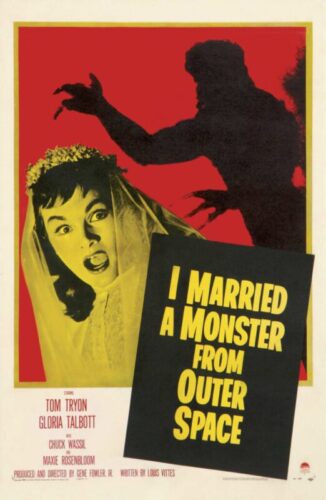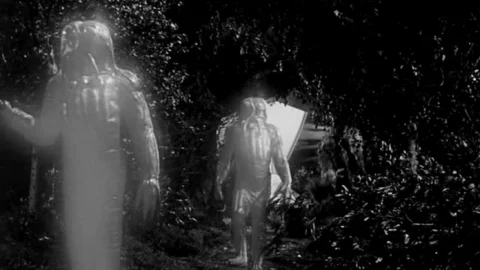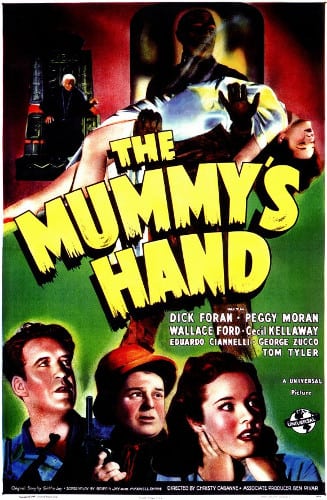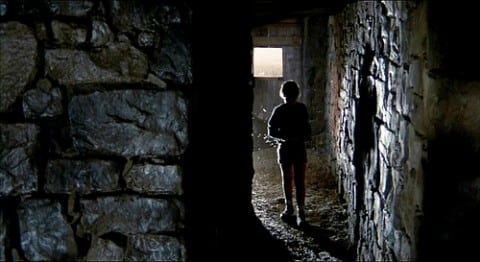I Married a Monster from Outer Space (1958)
Directed by: Gene Fowler Jr.
Written by: Louis Vittes
Starring: Gloria Talbott, Peter Baldwin, Robert Ivers, Tom Tryon
USA
AVAILABLE ON BLU-RAY [REGION B AUSTRALIA], DVD and DIGITAL
RUNNING TIME: 78 mins
REVIEWED BY: Dr Lenera

In an American small town, it’s the evening before Bill Fowler is due to marry Marge. He leaves his friends at the local bar and drives off, aiming to call in on Marge briefly before going home. However, it’s bad luck to do such a thing, and, when he stops his car so he doesn’t hit a body in the road, a humanoid creature fires a gun at him and he vapourises into nothing. Yet Bill does nup at the wedding though he’s late and, while the wedding night does take place, he often seems cold and distant, and says odd things as if he’s forgotten a great deal. A year later, Marge is still not pregnant even though the doctor assures her that she’s able to have children, while Bill kills a dog she bought for him as an anniversary present, and other men are beginning to act in the same way as him….

There was always something about aliens taking over humans or taking human form that scared me as a kid, back in the days when ’50 sci-fi was often shown on TV. I Married A Monster From Outer Space, which wrongly suggests something that doesn’t make much of an attempt to take itself seriously, was once shown much later than the others, so of course I did what I often did; snuck downstairs after my parents had gone to bed and watched it right up close to the TV so I could still hear it with the sound turned way down. And the film’s aliens, who appear quite often but usually in small flashes, truly unsettled me. Of course they weren’t going to have the same effect when viewed around four decades later, but it’s a pretty interesting effort nonetheless. The script reworks some ideas from Invaders Of Mars and Invasion Of The Body Snatchers, and the “Reds under the bed” influenced paranoia of those classics is present a bit, but it has some strong themes of its own, most notably a surprisingly critical look at marriage which often adopts a feminist perspective, while sex plays a very large part; the word may not be mentioned but it’s often referred to and plays a major part in the story. Somehow this lowly exploitation effort was able to hire John P. Fulton, who’d not long won an Academy Award for his work on The Ten Commandments, to do the special effects; they’re really good considering that this film really was cheap. There are some daft bits in the screenplay, which was no doubt written very quickly indeed, but there’s a fair amount of atmosphere, plus an emphasis on it being an intimate drama about a husband and wife which was unusual for the genre at the time. And what can be seen as the biggest flaw of all – the wooden acting by Tom Tryon – actually works in a way because for most of the time he’s playing an alien.
It marked Fowler’s second directorial effort following I Was a Teenage Werewolf which had been a considerable hit; the original title was actually IMAMFOS, but then it was decided that the actual words should replace the letters. Fowler said later, “I intended to make a film that was better than its title” .The screenplay was by Louis Vittes who, like Fowler, was given some creative freedom. However, Vittes was notoriously resistant to any changes to his writing. This annoyed Tryon and co-star Gloria Talbott who failed to get even very minor changes to their dialogue accepted. The script describes the aliens as having helmets and air hoses connected to tanks on their chests and/or backs. However, Charles Gemora, who designed the creatures as well as playing the most seen one, didn’t read the script properly, because he assumed the helmets and hoses were organic features of the aliens themselves. This mistake probably worked in the film’s favour, making the aliens more bizarre and unsettling. Shooting took just over two weeks in and around Los Angeles, including the much-used Bronson Canyon in Griffith Park, and at Paramount Studios. The dogs who attack the undisguised aliens near the end of the film were initially too scared to approach the costumed actors. The dogs were then acclimated to the presence of the suited actors, though perhaps too well, for when the time came to shoot the scene, the dogs didn’t attack the aliens, but jumped playfully around and on them instead. They were then trained to go for the “breathing tubes” on the costumes, but even this proved to be difficult, the actors playing the aliens having to guide the dogs to attack the “breathing tubes.” The film often played in a hugely successful double bill with The Blob; on its own it was also popular.
The titles appear over a background of outer space, looking like they’re coming out of the Earth. The music over the opening titles is odd; it’s basically the title music from Nathan Van Cleave’s score for Conquest Of Space but with new bits added. Of course I only even noticed this for two reasons: my deep interest in film music, and me having watched the George Pal film very recently. We then follow two guys as they enter the bar where we will spend quite a bit of time; they pass a necking couple who don’t even notice one of the men banging on their car, already introducing the element of sex which will dominate the proceedings throughout. Inside, two girls, clearly out on the pull, are wondering why the five men at a table don’t notice them. “Maybe they’re married or something”? “Well if we’re willing to overlook it, they certainly ought to”. The group is Bill and his friends, “The “Soon to be married, the married and the has been married”. Bill leaves but has his close encounter. We get the standard hand on the shoulder which usually causes a little shudder, followed by a view of the whole alien itself. Isn’t this rare? These films tend not to show their space visitors for some time. Bill shows up late for the wedding seeming somewhat different. He’s virtually emotionless, he asks bizarre questions [when it thunders, he enquires, “What’s that”?], he forgets to switch his lights on before he drives in the dark, and he won’t get all romantic on the big night, though he does seem to eventually go to bed with Marge, which can’t help but make us wonder how different from the norm the sex is – though as per the times it’s likely that Bill and Marge didn’t have sex before and that Marge is a virgin. But the next time we see her is when she’s writing a letter saying that she’s “frightened and bewildered” a year later, so things are clearly not what she expected.

It’s the day of their anniversary, and she buys him a cute dog who snarls at him, so Bill goes into the cellar where it’s tied up and grabs a hammer. He then decides not to bash the animal in with it, just to strangle it [so that makes it better I suppose], one of his hands effectively outstretching towards the camera. This is quite shocking, and soon after a cat gets it too! Bill – or rather Bill’s impersonator – claims to Marge that the dog must have been strangled by his collar while pulling on his tethered leash. Meanwhile other people, which include Bill’s friends, are going the same way as Bill. An alien fires a gun at them and mist envelopes their bodies, usually at night, and usually to people stumbling out of the bar. Marge, who can’t understand why she’s not pregnant as her doctor has told her that she should have no problems of that nature, follows Bill one night when he goes for a walk. He heads to an isolated area in the woods, where, in a rather haunting moment, she sees an alien leave Bill’s body and enter a mostly hidden spaceship, then, when she goes to touch Bill, he falls to the ground. Marge flees in panic but of course who will believe the seemingly crazy things that she says? Fellow wives of husbands who’ve gone strange would seem to be the most obvious people to talk to, but that won’t be easy when said husbands are often around. Then there’s the law, but even that may have been infiltrated. The feeling of not knowing who you can trust is well conveyed in much of the second half, especially seeing how some of these aliens, unlike their predecessors, can act very human indeed, but a lot of the emphasis is on our couple. Especially interesting is that alien Bill becomes increasingly sympathetic as he inherits human desires and emotions. At one point he confesses his feelings and she refuses to sleep with him, and we actually feel sorry for him a bit [even though he’s killed two animals]. These aliens are gentler than the norm, even if their aim is to mate with Earth’s women [not a common idea at the time though it would become one] to save their race from extinction because their females have all died.
The cheapness shows in things like the spacecraft being barely visible and a final battle which only features a few people and aliens [though there are some cool closeups of the alien’s skin repelling bullets], yet sights such as the mist covering people, dissolving body parts and the aliens themselves are pretty impressive – the latter so much so that it wasn’t necessary to place an Outer Limits– style optical shimmering effect [which Fowler was against] over them. One could ask some questions, if one was so inclined. If the aliens can’t drink alcohol then why do they go to the local bar, order drinks and then stare at them for hours, bringing suspicion on themselves? At the very end the aliens are revealed to have a large squadron of ships hovering over earth, and yet after a year they’ve still only partly infiltrated one small town – unless they’re in other places simultaneously? There’s much vagueness, even though we’re privy to conversations between the aliens themselves, and yet one cannot help but enjoy things such as sex being so prominent. In one moment one disguised alien says to another how humans “Do manage to enjoy themselves”; in context it tells us that he’s loving having sex with a human female. The town prostitute blatantly propositions almost any guy she comes across. Of course she pays the price, in a great little scene which is both creepy and sad. She sees a hooded person looking in a shop window and approaches him. His answer to her overtones is to vapourise her. Then we cut to what’s in the window. Dolls, symbolising childhood. What a neat way to create some pity for these creatures with no dialogue. Marriage is criticised throughout. We begin with a group of blokes griping about their servitude to said stifling institution, Yet the film then more adopts a more feminist point of view as Marge, the long-suffering yet not-so-obedient wife of an alien, becomes the main protagonist, even if matters resolve to a conventional normality right at the end [we want Marge to walk off with no man]. You could also see the film as a warning of marrying the wrong person.
One rather distracting aspect is the day for night footage. Granted, many movies of this vintage feature this, but here they seem to have made no attempt whatsoever to simulate night time, resulting in me actually being confused a couple of times as to when some stuff was supposed to be taking place. But Gloria Talbott’s performance as Marge is absolutely terrific; she totally sells the required gamut of emotions. She was a “scream queen” of the period, but on the evidence of this deserved to go further than she actually did. As for Tryon, I’ve seen him in other films and he’s just the same; very stiff. Still, Fowler keeps things progressing at a solid pace; there’s a lot of dialogue but you never feel that it’s wasted. The music score consists of tracks from other movies composed by Daniele Amfitheatrof, Hugo Friedhofer, Leith Stevens, Franz Waxman and Victor Young. Well, that’s certainly two great film composers we have there, but the score is just adequate in context, if not exactly detrimental and surprisingly cohesive. Of course this way of “scoring” films was once common for movies such as this one. And overall this particular effort has a certain resonance despite all the ways in which the tiny budget had to be met. It gets one to think not so much about the possibility of alien visitors [well, unless you’re like me who thinks often of that possibility anyway and can often be found watching the Blaze channel on TV], but more of things such as how well do we know the people that we marry? How people can change as a result of having tied the knot. Even how sex can actually be something quite different than expected to one who hasn’t experienced it before. And I think this gets to the heart of why films such as this remain relatively popular and known and get re-releases on home media why so many other films of the period have fallen by the wayside. They are often about stuff which many of us can relate to, ideas that have some meaning to us, yet can still be enjoyed as escapist genre fare.







Be the first to comment